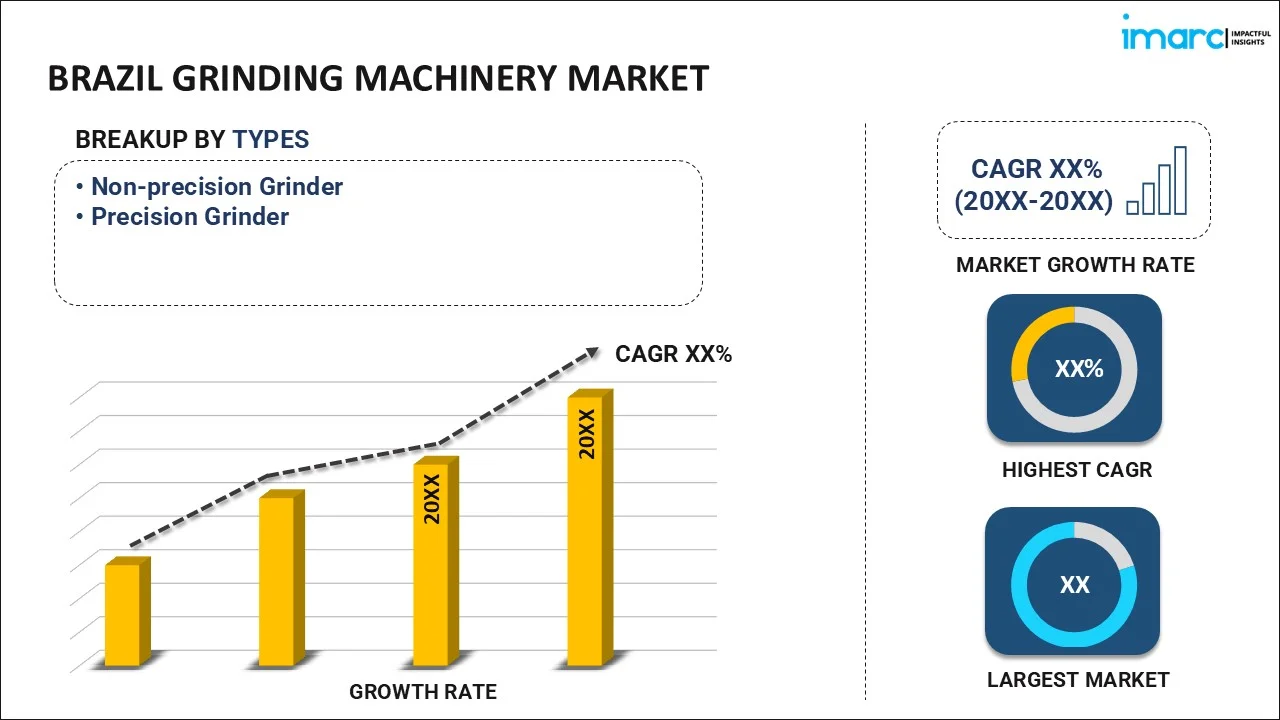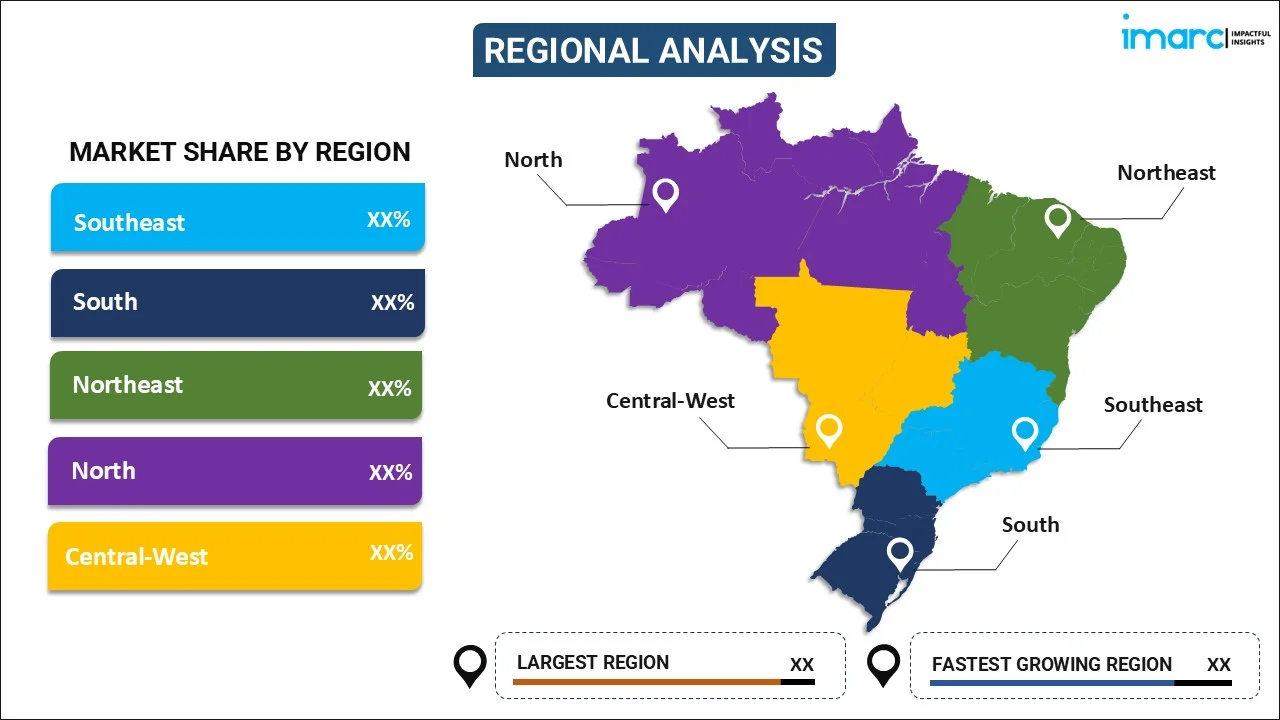
Brazil Grinding Machinery Market Size, Share, Trends and Forecast by Type, Application, and Region, 2026-2034
Brazil Grinding Machinery Market Overview:
The Brazil grinding machinery market size reached USD 112.2 Million in 2025. Looking forward, IMARC Group expects the market to reach USD 169.0 Million by 2034, exhibiting a growth rate (CAGR) of 4.66% during 2026-2034. The Brazil grinding machinery market share is expanding, driven by the growing environmental concerns and increasing energy costs, which are encouraging manufacturers to adopt energy-efficient tools, along with the ongoing innovations in technology, leading to the creation of high-precision grinding equipment across major industries.
|
Report Attribute
|
Key Statistics
|
|---|---|
|
Base Year
|
2025
|
|
Forecast Years
|
2026-2034
|
|
Historical Years
|
2020-2025
|
| Market Size in 2025 | USD 112.2 Million |
| Market Forecast in 2034 | USD 169.0 Million |
| Market Growth Rate (2026-2034) | 4.66% |
Brazil Grinding Machinery Market Trends:
Increasing Demand for Precision Grinding
The rising demand for precision grinding equipment, particularly from the automotive and aerospace sectors, is fueling the market. As manufacturers focus on producing high-quality precise components, advanced grinding machines that offer tight tolerances are gaining popularity. The high requirement for precision grinding is significantly influenced by its critical role in the oil production industry. For instance, in April 2023, according to the National Agency of Petroleum, Natural Gas, and Biofuels (ANP), Brazil’s hydrocarbon regulator, the country manufactured an average of 3.1 Million Barrels of oil per day. This trend is further driven by the need to improve production efficiency and reduce material waste. Innovations in computer numerical control (CNC) grinding machines, which enable greater automation and control, are being adopted across industries to meet the growing precision requirements.
Adoption of Energy-Efficient Technologies
Environmental concerns and rising energy costs are motivating manufacturers to adopt energy-efficient tools, which is impelling the Brazil grinding machinery market growth. Equipment with features, such as variable-speed motors, advanced cooling systems, and low-power usage, are being favored. These technologies not only reduce operational costs but also help industries to comply with sustainability goals. The shift towards greener manufacturing practices is also influencing equipment purchases, with companies in sectors like metalworking and construction investing in machines that offer both performance and energy savings. For instance, according to industry reports, in 2023, Eighty-nine percent of industrial firms adopted at least one environmental initiative or practice related to energy efficiency, recycling and reuse, water resources, solid waste, land use, and air emissions, indicating that such initiatives and practices have become quite common in industrial organizations in Brazil. Additionally, programs related to power optimization and water resources were executed, with over half of the businesses, 61.5% and 57.1 %, respectively, recognizing their adoption.
Growth of Automation and Smart Technologies
The increasing employment of automation and smart technologies to streamline operations and enhance productivity is offering a favorable Brazil grinding machinery market outlook. For instance, according to industry reports, private investment announcements in Brazil hit BRL 85.7 Billion for 2024-2035, covering infrastructure, machinery, research and development (R&D), and technology diversification, particularly in the semiconductor and high-tech sectors. Cumulative 2023 investments reached BRL 580.2 Billion, with BRL 130 Billion in the automotive sector, driven by the Internet of Things (IoT) innovations and government incentives. The assimilation of industry 4.0 technologies like data analytics and IoT sensors, allows real-time monitoring and predictive maintenance of grinding equipment. This reduces downtime, improves machine lifespan, and enhances overall efficiency.
Brazil Grinding Machinery Market Segmentation:
IMARC Group provides an analysis of the key trends in each segment of the market, along with forecasts at the regional level for 2026-2034. Our report has categorized the market based on type and application.
Type Insights:

- Non-precision Grinder
- Bench Grinder
- Portable Grinder
- Pedestal Grinder
- Flexible Grinder
- Precision Grinder
- Cylindrical Grinding Machines
- Surface Grinding Machines
- Centre-less Grinding Machines
- Tool and Cutter Grinding Machines
The report has provided a detailed breakup and analysis of the market based on the types. This includes non-precision grinder (bench grinder, portable grinder, pedestal grinder, and flexible grinder) and precision grinder (cylindrical grinding machines, surface grinding machines, centre-less grinding machines, and tool and cutter grinding machines).
Application Insights:
- Automotive
- Aerospace
- Medical
- Construction
- Industrial Manufacturing
- Electrical and Electronics
- Marine Industry
- Others
A detailed breakup and analysis of the market based on the applications have also been provided in the report. This includes automotive, aerospace, medical, construction, industrial manufacturing, electrical and electronics, marine industry, and others.
Regional Insights:

- Southeast
- South
- Northeast
- North
- Central-West
The report has also provided a comprehensive analysis of all the major regional markets, which include Southeast, South, Northeast, North, and Central-West.
Competitive Landscape:
The market research report has also provided a comprehensive analysis of the competitive landscape. Competitive analysis such as market structure, key player positioning, top winning strategies, competitive dashboard, and company evaluation quadrant has been covered in the report. Also, detailed profiles of all major companies have been provided.
Brazil Grinding Machinery Market News:
- In April 2024, NETZSCH Pumps & Systems, the prominent pump manufacturer, inaugurated the new ‘NOTOS® multi screw pump’ facility in Pomerode, Santa Catarina, Brazil. It aimed to provide superior multi-screw pumps specifically crafted for challenging applications. Alongside multi-screw pumps, the collection featured progressing cavity pumps, rotary lobe pumps, peristaltic pumps, and grinding systems.
- In April 2024, Nogueira Máquinas Agrícolas, active for more than 60 years in the agricultural industry, with operations in America, Africa, and the Middle East, was prepared to introduce its flagship products at Agrishow 2024, São Paulo, Brazil. The collection featured the FTN 1000 Power forage harvester, the VMN feed mixer range, the Express 5040 haying machine, the DPM line of choppers and grinders, alongside fertilizers and bagging equipment.
Brazil Grinding Machinery Market Report Coverage:
| Report Features | Details |
|---|---|
| Base Year of the Analysis | 2025 |
| Historical Period | 2020-2025 |
| Forecast Period | 2026-2034 |
| Units | Million USD |
| Scope of the Report |
Exploration of Historical Trends and Market Outlook, Industry Catalysts and Challenges, Segment-Wise Historical and Future Market Assessment:
|
| Types Covered |
|
| Applications Covered | Automotive, Aerospace, Medical, Construction, Industrial Manufacturing, Electrical and Electronics, Marine Industry, Others |
| Regions Covered | Southeast, South, Northeast, North, Central-West |
| Customization Scope | 10% Free Customization |
| Post-Sale Analyst Support | 10-12 Weeks |
| Delivery Format | PDF and Excel through Email (We can also provide the editable version of the report in PPT/Word format on special request) |
Key Questions Answered in This Report:
- How has the Brazil grinding machinery market performed so far and how will it perform in the coming years?
- What is the breakup of the Brazil grinding machinery market on the basis of type?
- What is the breakup of the Brazil grinding machinery market on the basis of application?
- What are the various stages in the value chain of the Brazil grinding machinery market?
- What are the key driving factors and challenges in the Brazil grinding machinery market?
- What is the structure of the Brazil grinding machinery market and who are the key players?
- What is the degree of competition in the Brazil grinding machinery market?
Key Benefits for Stakeholders:
- IMARC’s industry report offers a comprehensive quantitative analysis of various market segments, historical and current market trends, market forecasts, and dynamics of the Brazil grinding machinery market from 2020-2034.
- The research report provides the latest information on the market drivers, challenges, and opportunities in the Brazil grinding machinery market.
- Porter's five forces analysis assist stakeholders in assessing the impact of new entrants, competitive rivalry, supplier power, buyer power, and the threat of substitution. It helps stakeholders to analyze the level of competition within the Brazil grinding machinery industry and its attractiveness.
- Competitive landscape allows stakeholders to understand their competitive environment and provides an insight into the current positions of key players in the market.
Need more help?
- Speak to our experienced analysts for insights on the current market scenarios.
- Include additional segments and countries to customize the report as per your requirement.
- Gain an unparalleled competitive advantage in your domain by understanding how to utilize the report and positively impacting your operations and revenue.
- For further assistance, please connect with our analysts.
 Request Customization
Request Customization
 Speak to an Analyst
Speak to an Analyst
 Request Brochure
Request Brochure
 Inquire Before Buying
Inquire Before Buying




.webp)




.webp)












